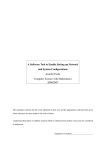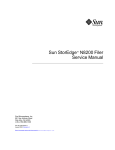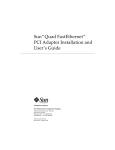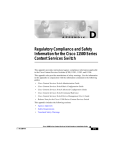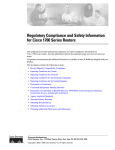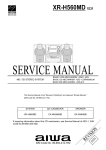Download Cisco BTS 10200 Installation guide
Transcript
CISCO CONFIDENTIAL Cisco BTS 10200 Softswitch Cabling, VLAN, and IRDP Procedures The purpose of this procedure is to explain how to: • Cable a new Cisco BTS 10200 Softswitch system • Provision the virtual local area network (VLAN) on the Cisco 2924M Ethernet Switches (hubs) • Enable Internet Control Protocol (ICMP) Router Discovery Protocol (IRDP) functionality on the Cisco BTS 10200 Softswitch and on the Cisco routers adjacent to the Cisco BTS 10200 Softswitch This procedure is applicable to a Cisco BTS 10200 Softswitch with active and standby components colocated in the same office. Note This procedure is applicable only to systems with Continuous Computing hardware. If you are using other hardware, contact your Cisco account team for procedures. This procedure is not applicable to Cisco BTS 10200 Softswitch systems that are already in service. Caution Do not use this procedure to change the cabling of an in-service Cisco BTS 10200 Softswitch, because that will cause interruption of service. It is not necessary to change the cabling of in-service systems to match this document. Front View of Rack-Mounted Equipment The front view of the standard Cisco BTS 10200 Softswitch system rack is shown in Figure 1 on page 2. Corporate Headquarters: Cisco Systems, Inc., 170 West Tasman Drive, San Jose, CA 95134-1706 USA Copyright © 2003. Cisco Systems, Inc. All rights reserved. Front View of Rack-Mounted Equipment CISCO CONFIDENTIAL Figure 1 Standard Cisco BTS 10200 Softswitch Rack Configuration Alarm panel, PDU power feed 8A Filler panel PDU (DC systems) 1U 1U 1U 2U Filler panel ON APP R ALRM YES NO OFF CONS EMS B (AXi) CCN node address = 1 PDU power feed 1A/1B PW 4U PW R R ON APP ALRM OFF CONS YES NO Call agent B (AXmp) CCN node address = 2 PDU power feed 2A/2B 6U Filler panel (Expansion CA or Ext. FS) 6U 2.36 m 93 in. 48U (ref) Ethernet switch (HUB) B (2924M) PDU power feed 6A/6B 5U Ethernet switch (HUB) A (2924M) PDU power feed 7A/7B 4U Filler panel Filler panel 2U ON APP R ALRM YES NO OFF CONS EMS A (AXi) CCN node address = 3 PDU power feed 4A/4B PW 4U PW R R ON APP ALRM OFF CONS YES NO Call agent A (AXmp) CCN node address =4 PDU power feed 5A/5B 6U Filler panel (Expansion CA or Ext. FS) 69411 6U 2 OL-2906-01 Network VLAN Diagram CISCO CONFIDENTIAL Network VLAN Diagram Figure 2 shows the physical interfaces and VLAN connections. Figure 2 Network VLAN Diagram First uplink for external communications (connect to router). Used for connection to external NEs and DNS services via IRDP-enabled network. Uplink for external access to hosts (connect to router). Used for management services (SSH, SFTP, etc.) and outbound billing data (FTP). Physical interface Second uplink for external communications (connect to router). Used for connection to external NEs and DNS services via IRDP-enabled network. Alarm panel Data carried EMS/BDMS Side B EMS/BDMS Side A Management services HME0 HME0 Management services OMS Hub comm. (1) QFE0 QFE0 OMS Hub comm. (1) OMS Hub comm. (2) QFE1 QFE1 OMS Hub comm. (2) EMS redundancy/billing (1) QFE2 QFE2 EMS redundancy/billing (1) EMS redundancy/billing (2) QFE3 QFE3 EMS redundancy/billing (2) CA/FS Side A CA/FS Side B Hub A Management services HME0 VLAN1 HME0 Management services VoIP signaling, OMS Hub comm. (1) QFE0 VLAN2 QFE0 VoIP signaling, OMS Hub comm. (1) CA/FS redundancy (1) QFE1 VLAN3 QFE1 CA/FS redundancy (1) Billing (1) QFE2 VLAN4 QFE2 Billing (1) CA-FS comm. (1) QFE3 VLAN5 QFE3 CA-FS comm. (1) VoIP signaling, OMS Hub comm. (2) QFE4 VLAN6 CA/FS redundancy (2) QFE5 VLAN7 QFE5 CA/FS redundancy (2) Billing (2) QFE6 VLAN8 QFE6 Billing (2) CA-FS comm. (2) QFE7 VLAN9 QFE7 CA-FS comm. (2) Hub B VoIP signaling, OMS Hub comm. (2) 87013 QFE4 Acronyms used in Figure 2: EMS/BDMS = Element Management System/Bulk Data Management System CA/FS = Call Agent/Feature Server Comm. = communications over OMS Hub NE = Network Element SSH = Secure Shell SFTP = Secure File Transfer Protocol (FTP) DNS = Domain Name Server VoIP = Voice over IP IRDP = Internet Control Message Protocol (ICMP) Router Discovery Protocol Notes for Figure 2: OL-2906-01 1. For EMS/BDMS, qfe0 and qfe1 are also used for redundancy communication. 2. For CA/FS, qfe0 and qfe4 are also used for redundancy communication. 3. VLAN2 and VLAN6 are used primarily for VoIP signaling based on protocols such as MGCP, SIP, H.323, and so forth. 3 Labeling the Cables CISCO CONFIDENTIAL 4. Caution If each of the three external uplinks is not connected as described in Note #4, a single point of failure could cause a traffic interruption. 5. Caution Note To support full system redundancy, it is necessary to connect each of the three Cisco BTS 10200 Softswitch external uplinks to a different network with diverse routing paths to the related external network elements (NEs) and services (such as OSS, DNS, media gateways, and announcement servers). To ensure redundancy of the DNS lookup function in the event of a network outage, it is strongly recommended to have two DNS units reachable via separate networks with diverse routing paths. If both DNS servers become unreachable, a traffic interruption will occur. Ethernet ports on the rear panels of some EMS and CA units are labeled ETH0, ZNB0, ZNB1, and so forth. On some units these ports are labeled hme0, qfe0, qfe1, and so forth. Regardless of the labeling style, the Cisco BTS 10200 Softswitch functionality is the same. Labeling the Cables Make sure that you have all the cables labeled before you begin. Label the cables according to the procedure in Appendix A: Cable Labeling, page 22. Connect Ethernet Cables To EMS and CA Units Follow these steps to connect the Ethernet cables. Refer to Figure 1 on page 2 to identify the specific units in the rack. Step 1 Obtain the 10 Ethernet cables needed for connections between the rear panel of the Element Management Systems (EMS A and EMS B) and the two Cisco 2924M Ethernet Switches (Hub A and Hub B). These cables are listed in Table 1 in Appendix B: Cable List, page 23. Step 2 Connect the 10 Ethernet cables to the ports on the rear panel of the EMS units as listed in Table 1 in Appendix B: Cable List, page 23. Figure 3 shows the rear view of the EMS. On the EMS, use ports ETH0 and ZNB0 through ZNB3. Note 4 Figure 3 and Figure 4 are not to scale. OL-2906-01 Connect CONSOLE Ethernet Cables to Alarm Panel CISCO CONFIDENTIAL Figure 3 Partial Rear View of the EMS Unit Showing Ethernet Ports ZNB1 ZNB0 ZNB2 ZNB3 CCPU B CCPU A 54352 ETH0 EMS (AXi) Step 3 Obtain the 18 Ethernet cables needed for connections between the rear panel of the Call Agents (CA A and CA B) and the two Cisco 2924M Ethernet Switches (Hub A and Hub B). These cables are listed in Table 1 in Appendix B: Cable List, page 23. Step 4 Connect the 18 Ethernet cables to the ports on the rear panel of the CA units as listed in Table 1 in Appendix B: Cable List, page 23. Figure 4 shows the rear view of the CA. On the CA, use ports ETH0 and ZNB0 through ZNB7. Partial Rear View of the CA Unit Showing Ethernet Ports ZNB4 ZNB6 ZNB5 ZNB7 ETH0 SPE0 SPE1 ZNB0 ZNB1 ZNB2 ZNB3 SPE2 SPE3 CCPU B CCPU A 54353 Figure 4 Call agent (AXmp) Connect CONSOLE Ethernet Cables to Alarm Panel Connect the two CONSOLE Ethernet cables from the Alarm Panel to the Hubs as described in this section. OL-2906-01 5 Connect CCPUnet Cables and Terminating Resistors CISCO CONFIDENTIAL Note These two CONSOLE cables are specially designed for the CONSOLE connections. Make sure that you are using the correct cables. Note One end of the CONSOLE cable is labeled “switch” and the other is labeled “net CCN”. The “switch” end must connect to the Hub and the “net CCN” end must connect to the Alarm Panel. Step 1 Refer to Figure 1 on page 2 to identify which Cisco 2924M Ethernet Switch (Hub) is designated Ethernet Switch A and which is Ethernet Switch B. Step 2 Connect the “net CCN” end of a CONSOLE cable to port SER 1 on the Alarm Panel, and the “switch” end to the CONSOLE port on the rear panel of Ethernet switch (Hub) A. Step 3 Connect the “net CCN” end of a CONSOLE cable to port SER 2 on the Alarm Panel, and the “switch” end to the CONSOLE port on the rear panel of Ethernet switch (Hub) B. The rear view of the alarm panel is shown in Figure 5. (The drawing is not to scale.) Rear View of Alarm Panel CCPUNet HUB A LINE 1 2 3 4 5 6 7 1 2 3 4 5 6 7 CCPUNet HUB B SER 1 SER 3 SER 5 SER 7 SER 9 SER 11 CONS eth1 I/O CABLE A SER 2 SER 4 SER 6 SER 8 SER 10 SER 12 COM1 eth0 I/O CABLE B -48V A -48V B AC IN 8 8 REM 100-240 V50-60 HZ 40W 69752 Figure 5 Connect CCPUnet Cables and Terminating Resistors Follow these steps to connect the intershelf signaling (CCPUnet) cables and terminating resistors: Step 1 Obtain the eight CCPUnet cables (four for CCPU A and four for CCPU B). Step 2 Connect the CCPUnet cables between the machines as listed in Table 1 on page 23. Make sure that you connect cables labeled CCPU A to the CCPU A ports, and cables labeled CCPU B to the CCPU B ports. Note Step 3 6 Refer to Figure 3 through Figure 5 to locate the CCPU ports on the rear panels. Connect the two terminating resistors (part # CCPU 012 02150-02602 REV 00) to the Alarm Panel (Figure 5) as follows: Connect one resistor to CCPUNet HUB A port 5, and the other resistor to CCPUNet HUB B port 5. OL-2906-01 Connect External Network Uplink Cables to Ethernet Switches CISCO CONFIDENTIAL Connect External Network Uplink Cables to Ethernet Switches Follow these steps to connect the external network uplink cables to the Ethernet switches: Step 1 Refer to Figure 1 on page 2 to identify which Cisco 2924M Ethernet Switch is designated Ethernet Switch A and which is Ethernet Switch B. Step 2 If your local network documentation calls for gigabit Ethernet, contact Cisco TAC for assistance. Step 3 If your local network documentation calls for 100 Mb Ethernet, connect the applicable network uplink cables as listed in Table 1. Ports #21 through 24 are available for this use. Step 4 After installing the uplink cables, record the necessary information on a copy of Table 1 or similar document according to local procedures. Connect SS7 Signaling Cables To CA Follow these steps to connect the SS7 signaling cables to the CA units of the Cisco BTS 10200 Softswitch: Step 1 Refer to Figure 1 on page 2 to identify which unit is CA A and which is CA B. Step 2 Connect T1 cables for SS7 signaling to the SPE0 and SPE1 connectors on CA A (see Figure 6). Note OL-2906-01 SPE2 and SPE3 are not used. Step 3 Connect T1 cables for SS7 signaling to the SPE0 and SPE1 connectors on CA B. Step 4 Route the other ends of these T1 cables as specified in local network documentation, and add (write in) this information on a copy of Table 1 or similar document. 7 Connect Internal Power and Grounding Cables CISCO CONFIDENTIAL Figure 6 Location of SPE0 and SPE1 Connectors on CA Backplane ZNB4 ZNB6 ZNB5 ZNB7 ETH0 SPE0 SPE1 ZNB0 ZNB1 ZNB2 ZNB3 SPE2 SPE3 CCPU B CCPU A 54355 Location of SPE0 and SPE1 connectors (Used for SS7 signaling) Call agent (AXmp) Connect Internal Power and Grounding Cables After obtaining approval from a supervisor, an authorized power installer should follow these steps to connect DC power cables and ground cables from the power distribution unit (PDU) to the other devices in the Cisco BTS 10200 Softswitch rack. Note If you need to connect an AC system, contact your Cisco account team for assistance. IMPORTANT SAFETY INSTRUCTIONS Warning This warning symbol means danger. You are in a situation that could cause bodily injury. Before you work on any equipment, be aware of the hazards involved with electrical circuitry and be familiar with standard practices for preventing accidents. To see translations of the warnings that appear in this publication, refer to the translated safety warnings that accompanied this device. Note: SAVE THESE INSTRUCTIONS Note: This documentation is to be used in conjunction with the specific product installation guide that shipped with the product. Please refer to the Installation Guide, Configuration Guide, or other enclosed additional documentation for further details. Step 1 8 Connect the intershelf DC power cables from the PDU to each of the devices in the rack. See Table 1 on page 23 for the complete cabling list. OL-2906-01 Connect Site Power and Grounding Cables To PDU CISCO CONFIDENTIAL Step 2 Warning Following local electrical codes, connect the ground cables from each of the devices in the rack to the PDU grounding point (either of the two grounding screws on the PDU rear panel). See Table 1 for the complete cabling list. This equipment must be grounded. Never defeat the ground conductor or operate the equipment in the absence of a suitably installed ground conductor. Contact the appropriate electrical inspection authority or an electrician if you are uncertain that suitable grounding is available. Connect Site Power and Grounding Cables To PDU After obtaining approval from a supervisor, an authorized power installer should follow these steps to connect the DC power from the office batteries to the PDU. Note For DC systems the nominal current rating for a complete Cisco BTS 10200 Softswitch system is 26A at -48 VDC, and the maximum current rating is 40A at -48 VDC. Note If you need to connect an AC system, contact your Cisco account team for assistance. IMPORTANT SAFETY INSTRUCTIONS Warning This warning symbol means danger. You are in a situation that could cause bodily injury. Before you work on any equipment, be aware of the hazards involved with electrical circuitry and be familiar with standard practices for preventing accidents. To see translations of the warnings that appear in this publication, refer to the translated safety warnings that accompanied this device. Note: SAVE THESE INSTRUCTIONS Note: This documentation is to be used in conjunction with the specific product installation guide that shipped with the product. Please refer to the Installation Guide, Configuration Guide, or other enclosed additional documentation for further details. OL-2906-01 Step 1 Following local electrical codes, connect power cables from the power distribution unit (PDU) to dual feeds (“A” and “B”) on the office batteries. Use Listed two-hole crimped lugs on the PDU side of the cable. Step 2 Following local electrical codes, connect the PDU grounding point (both of the two grounding screws on the PDU rear panel) to CO earth ground using 6 AWG wire or heavier and a Listed two-hole crimped lug. 9 Connect Site Power and Grounding Cables To PDU CISCO CONFIDENTIAL Warning 10 This equipment must be grounded. Never defeat the ground conductor or operate the equipment in the absence of a suitably installed ground conductor. Contact the appropriate electrical inspection authority or an electrician if you are uncertain that suitable grounding is available. OL-2906-01 Provision VLANs CISCO CONFIDENTIAL Provision VLANs Follow the procedures in this section to provision the VLANs on the Cisco 2924M Ethernet Switches (Hubs). You will need to enter a password to log on to these hubs. Provision VLANs On Hub A Follow these steps to provision the VLANs on the Cisco 2924M Ethernet Switch A (Hub A): Step 1 Connect a console cable to the Hub A console port. Use Figure 1 on page 2 to help identify which machine is designated as Hub A. Step 2 Switch> Enter: enable Step 3 The system will prompt you for a password. Enter the password. Step 4 Switch# Enter: config t The system will respond with the following prompt: Switch (config)# Note Step 5 Tip Copy the entire config text and paste at the Switch (config)# prompt. If you are viewing a pdf file, you can get an electronic copy of this config text using the following method: Select the “Text Select Tool” (the large “T” in the Adobe Acrobat toolbar above this file). Select all the config text on this page (Acrobat allows you to copy from only one page at a time.) Use the Edit/Copy feature (or right click) to get an electronic copy. Paste into a text document. Repeat on the following pages until you have all the necessary text in your text file. Copy all the text in your text file, and paste it into your XTerm window. The config text (for Step 5) is as follows. See the Tips paragraph above for assistance with copying: hostname switch-a ! interface FastEthernet0/1 description 120-Network Name-Redundancy1 switchport access vlan 146 ! interface FastEthernet0/2 description 120-Network Name-Redundancy1 switchport access vlan 146 ! interface FastEthernet0/3 description 120-Network Name-Redundancy1 switchport access vlan 146 OL-2906-01 11 Provision VLANs CISCO CONFIDENTIAL ! interface FastEthernet0/4 description 120-Network Name-Redundancy1 switchport access vlan 146 ! interface FastEthernet0/5 description 122-Network Name-Billing1 switchport access vlan 147 ! interface FastEthernet0/6 description 122-Network Name-Billing1 switchport access vlan 147 ! interface FastEthernet0/7 description 122-Network Name-Billing1 switchport access vlan 147 ! interface FastEthernet0/8 description 122-Network Name-Billing1 switchport access vlan 147 ! interface FastEthernet0/9 description 124-Network Name-FeatureServer1 switchport access vlan 148 ! interface FastEthernet0/10 description 124-Network Name-FeatureServer1 switchport access vlan 148 ! interface FastEthernet0/11 description 225-Network Name-MGCP1 switchport access vlan 149 ! interface FastEthernet0/12 description 225-Network Name-MGCP1 switchport access vlan 149 ! interface FastEthernet0/13 12 OL-2906-01 Provision VLANs CISCO CONFIDENTIAL description 225-Network Name-MGCP1 switchport access vlan 149 ! interface FastEthernet0/14 description 225-Network Name-MGCP1 switchport access vlan 149 ! interface FastEthernet0/15 description 225-Network Name-MGCP1 switchport access vlan 149 ! interface FastEthernet0/16 description 224-Network Name-Telnet switchport access vlan 150 ! interface FastEthernet0/17 description 224-Network Name-Telnet switchport access vlan 150 ! interface FastEthernet0/18 description 224-Network Name-Telnet switchport access vlan 150 ! interface FastEthernet0/19 description 224-Network Name-Telnet switchport access vlan 150 ! interface FastEthernet0/20 description 224-Network Name-Telnet switchport access vlan 150 ! interface FastEthernet0/21 description 224-Network Name-Telnet switchport access vlan 150 ! interface FastEthernet0/22 description 224-Network Name-Telnet switchport access vlan 150 OL-2906-01 13 Provision VLANs CISCO CONFIDENTIAL ! interface FastEthernet0/23 description 224-Network Name-Telnet switchport access vlan 150 ! interface FastEthernet0/24 Step 6 Add the VLANs to the database using the following commands: switch-a#vlan database switch-a(vlan)#vlan 146 switch-a(vlan)#vlan 147 switch-a(vlan)#vlan 148 switch-a(vlan)#vlan 149 switch-a(vlan)#vlan 150 switch-a(vlan)#exit Step 7 After the system exits, write the changes to memory using the following command: write mem Step 8 Display the VLAN status using the show vlan command at the Enter prompt: sh vlan Step 9 Verify that the status display includes response lines exactly as shown in the following system response: switch-a#show vlan VLAN Name Status Ports ---- -------------------------------- --------- ------------------------------1 default Fa0/24 146 VLAN0146 active Fa0/1, Fa0/2, Fa0/3, Fa0/4 147 VLAN0147 active Fa0/5, Fa0/6, Fa0/7, Fa0/8 148 VLAN0148 active Fa0/9, Fa0/10 149 VLAN0149 active Fa0/11, Fa0/12, Fa0/13, Fa0/14, Fa0/15 150 VLAN0150 active Fa0/16, Fa0/17, Fa0/18, Fa0/19, Fa0/20, Fa0/21, Fa0/22, Fa0/23 Note 14 active Ignore the additional lines of information displayed. OL-2906-01 Provision VLANs CISCO CONFIDENTIAL Provision VLANs On Hub B Follow these steps to provision the VLANs on Cisco 2924M Ethernet Switch B (Hub B): Step 1 Connect a console cable to the Hub B console port. Use Figure 1 on page 2 to help identify which machine is designated as Hub B. Step 2 Switch> Enter: enable Step 3 The system will prompt you for a password. Enter the password. Step 4 Switch# Enter: config t The system will respond with the following prompt: Switch (config)# Note Step 5 Tip Copy the entire config text and paste at the Switch (config)# prompt. If you are viewing a pdf file, you can get an electronic copy of this config text using the following method: Select the “Text Select Tool” (the large “T” in the Adobe Acrobat toolbar above this file). Select all the config text on this page (Acrobat allows you to copy from only one page at a time.) Use the Edit/Copy feature (or right click) to get an electronic copy. Paste into a text document. Repeat on the following pages until you have all the necessary text in your text file. Copy all the text in your text file, and paste it into your XTerm window. The config text (for Step 5) is as follows. See the Tips paragraph above for assistance with copying: hostname switch-b ! interface FastEthernet0/1 description 121-Network Name-Redundancy2 switchport access vlan 146 ! interface FastEthernet0/2 description 121-Network Name-Redundancy2 switchport access vlan 146 ! interface FastEthernet0/3 description 121-Network Name-Redundancy2 switchport access vlan 146 ! interface FastEthernet0/4 description 121-Network Name-Redundancy2 switchport access vlan 146 ! OL-2906-01 15 Provision VLANs CISCO CONFIDENTIAL interface FastEthernet0/5 description 123-Network Name-Billing2 switchport access vlan 147 ! interface FastEthernet0/6 description 123-Network Name-Billing2 switchport access vlan 147 ! interface FastEthernet0/7 description 123-Network Name-Billing2 switchport access vlan 147 ! interface FastEthernet0/8 description 123-Network Name-Billing2 switchport access vlan 147 ! interface FastEthernet0/9 description 124-Network Name-FeatureServer2 switchport access vlan 148 ! interface FastEthernet0/10 description 124-Network Name-FeatureServer2 switchport access vlan 148 ! interface FastEthernet0/11 description 226-Network Name-MGCP2 switchport access vlan 149 ! interface FastEthernet0/12 description 226-Network Name-MGCP2 switchport access vlan 149 ! interface FastEthernet0/13 description 226-Network Name-MGCP2 switchport access vlan 149 ! interface FastEthernet0/14 description 226-Network Name-MGCP2 16 OL-2906-01 Provision VLANs CISCO CONFIDENTIAL switchport access vlan 149 ! interface FastEthernet0/15 description 226-Network Name-MGCP2 switchport access vlan 149 ! interface FastEthernet0/16 ! interface FastEthernet0/17 ! interface FastEthernet0/18 ! interface FastEthernet0/19 ! interface FastEthernet0/20 ! interface FastEthernet0/21 ! interface FastEthernet0/22 ! interface FastEthernet0/23 ! interface FastEthernet0/24 Step 6 Add the VLANs to the database using the following commands: switch-b#vlan database switch-b(vlan)#vlan 146 switch-b(vlan)#vlan 147 switch-b(vlan)#vlan 148 switch-b(vlan)#vlan 149 switch-b(vlan)#exit Step 7 After the system exits, write the changes to memory using the following command: write mem Step 8 Display the VLAN status using the show vlan command at the Enter prompt: sh vlan OL-2906-01 17 Provision VLANs CISCO CONFIDENTIAL Step 9 Verify that the status display includes response lines exactly as shown in the following system response: switch-b#show vlan VLAN Name Status Ports ---- -------------------------------- --------- ------------------------------1 default active Fa0/16, Fa0/17, Fa0/18, Fa0/19, Fa0/20, Fa0/21, Fa0/22, Fa0/23, Fa0/24 146 VLAN0146 active Fa0/1, Fa0/2, Fa0/3, Fa0/4 147 VLAN0147 active Fa0/5, Fa0/6, Fa0/7, Fa0/8 148 VLAN0148 active Fa0/9, Fa0/10 149 VLAN0149 active Fa0/11, Fa0/12, Fa0/13, Fa0/14, Fa0/15 Note 18 Ignore the additional lines of information displayed. OL-2906-01 Enable IRDP CISCO CONFIDENTIAL Enable IRDP This section discusses how to enable IRDP functionality on the Cisco BTS 10200 Softswitch and on the network router. Enable IRDP on the Cisco BTS 10200 Softswitch Follow these steps to enable IRDP on the Cisco BTS 10200 Softswitch. Note You should already have the Cisco BTS 10200 Softswitch application software installed on the system. Step 1 Remove the defaultrouter file from /etc. Step 2 There should be three default routes in the routing table. Remove all three of these with the following command: route delete net default <gateway address> Step 3 Execute the following command: /usr/sbin/in.rdisc -s -f Step 4 Note Step 5 Edit S69inet and search and replace for rdisc -s with rdisc -s -f. This will ensure that reboot will enable the irdp daemon. Put the following lines into the S68inet file: if [ -f /usr/sbin/in.routed ]; then \mv -f /usr/sbin/in.routed /usr/sbin/in.routed.org OL-2906-01 19 Enable IRDP CISCO CONFIDENTIAL Enable IRDP on Adjacent Cisco Routers If you are enabling IRDP on Cisco routers adjacent to the Cisco BTS 10200 Softswitch, follow these steps. If you have any questions about setup of these routers, contact your system administrator. If you need additional assistance, contact Cisco TAC. Step 1 Verify that you have the network information data sheet (NIDS) applicable to this Cisco BTS 10200 Softswitch. If necessary, contact your network administrator to verify that you have the correct NIDS. Step 2 On default gateway interfaces for Network2 and Network3 (as defined in the NIDS) enable IRDP using the following commands: config t interface <Fast Ethernet interface number (see NIDS)> ip irdp ip irdp maxadvertinterval 4 ip irdp minadvertinterval 3 ip irdp holdtime 10 Step 3 Validate the configuration by performing the following command on both CA/FS hosts and both EMS hosts: login as root #netstat -rn Step 4 View the display and verify that each default route was populated dynamically by IRDP. Verify IRDP Functions Follow these steps to verify that IRDP is functioning properly on the network: Side A CA Perform Step 1 through Step 11 on the side A CA. Step 1 Login to the side A CA as root. Step 2 Display the IRDP daemon status by entering the following command: ps -ef|grep in.rdisc Step 3 20 View the display and verify that each default route was populated dynamically by IRDP. The display should include the following information: /usr/sbin/in.rdisc -s -f. (This indicates that IRDP is running properly.) OL-2906-01 Verify Interfaces CISCO CONFIDENTIAL Step 4 Display the routing table by entering the following command: netstat -rn Step 5 Verify that the routing table shows two default routes, one on interface ZNB0 and one on ZNB4. Step 6 Unplug the interface ZNB0 link at the back of the side A CA. Step 7 Display the routing table by entering the following command: netstat -rn Step 8 Verify that the route for interface ZNB0 does not appear in the routing table. Note When a link is unplugged or plugged back in, it may take 5 to 10 seconds for the IRDP function to automatically update. Step 9 Plug the interface ZNB0 link back in to the side A CA. Step 10 Display the routing table (netstat -rn) and verify that the route for interface ZNB0 appears in the routing table again. Step 11 Repeat Step 6 through Step 10 for the interface ZNB4 link. Side B CA Repeat Step 1 through Step 11 for the side B CA. Verify Interfaces Follow these steps to verify that all interfaces are configured on all computing elements: Step 1 If the Cisco BTS 10200 Softswitch application software has already been installed on the system, go to Step 2. If the application has not been installed, go to Step 4. Step 2 (If the Cisco BTS 10200 Softswitch application software has already been installed on the system) check the interface configurations using the following command on each of the four platforms (two EMS units and two CA/FS units): Enter: checkCFG Step 3 The system should display the message Validating..... If no errors are found during validation, the system will display the message No errors found. Verify that the No errors found message is displayed. Note Step 4 OL-2906-01 If the system does display an error, contact Cisco TAC for assistance. If the Cisco BTS 10200 Softswitch application software has not been installed on the system, install the application using the Application Installation procedure provided by Cisco. That procedure contains the appropriate commands to check the configurations (checkCFG). 21 Appendix A: Cable Labeling CISCO CONFIDENTIAL Appendix A: Cable Labeling Cables are labeled at both ends with the cable numbers listed in Table 1. Follow these steps to create and attach the labels. Note As listed in Table 1, some of the cables require labeling and others do not. Step 1 Make each label by copying the applicable number from Table 1 onto the label. Be sure to duplicate the number several times onto the label, as shown in Figure 7, to make it easier to read. (If desired, make the labels for all cables in one print run.) Step 2 On a work bench or assembly table, position a cable so that one connector is on your left and the cable goes off to the right. (See Figure 7.) Step 3 Attach the appropriate label to the cable as shown in Figure 7. Step 4 Turn the cable around so that the other connector is on your left with the cable going off to the right. Step 5 Repeat Step 2 and Step 3 for this side of the cable. The completed cable should look like the example shown in Figure 8. Step 6 Repeat these steps for all cables in the rack, using the numbers from the cable list (Table 1). Labeling Specification #16 #16 #16 #16 #16 Surface of connector that is flush with rear panel when installed. Cable #16 #16 #16 Label (example) to match cable list 1 inch Completed Cable Example #16 #16 #16 22 #16 #16 #16 Figure 8 54358 Connector Multiple rows on label, sufficient to ensure that label can be read without need to rotate or twist cable. 54357 Figure 7 OL-2906-01 Appendix B: Cable List CISCO CONFIDENTIAL Appendix B: Cable List Table 1 lists the cable numbers and connections. Table 1 OL-2906-01 Cable List (See Procedure for Descriptions and Drawings) From (Unit, Port) To (Unit, Port) Cable No. CA-A ETH0 HUB-A 16 #1 CA-A ZNB0 HUB-A 11 #2 CA-A ZNB1 HUB-A 1 #3 CA-A ZNB2 HUB-A 5 #4 CA-A ZNB3 HUB-A 9 #5 CA-A ZNB4 HUB-B 11 #6 CA-A ZNB5 HUB-B 1 #7 CA-A ZNB6 HUB-B 5 #8 CA-A ZNB7 HUB-B 9 #9 CA-B ETH0 HUB-A 17 #10 CA-B ZNB0 HUB-A 12 #11 CA-B ZNB1 HUB-A 2 #12 CA-B ZNB2 HUB-A 6 #13 CA-B ZNB3 HUB-A 10 #14 CA-B ZNB4 HUB-B 12 #15 CA-B ZNB5 HUB-B 2 #16 CA-B ZNB6 HUB-B 6 #17 CA-B ZNB7 HUB-B 10 #18 EMS-A ETH0 HUB-A 18 #19 EMS-A ZNB0 HUB-A 13 #20 EMS-A ZNB1 HUB-B 13 #21 EMS-A ZNB2 HUB-A 7 #22 EMS-A ZNB3 HUB-B 7 #23 EMS-B ETH0 HUB-A 19 #24 EMS-B ZNB0 HUB-A 14 #25 EMS-B ZNB1 HUB-B 14 #26 EMS-B ZNB2 HUB-A 8 #27 EMS-B ZNB3 HUB-B 8 #28 1 HUB-A 21 (see footnote 1) Uplink for Telnet (Network 1) HUB-A 15 (see footnote 1) Uplink for MGCP1 1 (Network 2) 23 Appendix B: Cable List CISCO CONFIDENTIAL Table 1 Cable List (See Procedure for Descriptions and Drawings) (continued) From (Unit, Port) To (Unit, Port) HUB-B 15 (see footnote 1) Uplink for MGCP2 1 (Network 3) CA-A SPE02 (see footnote 2) CA-A SPE12 (see footnote 2) CA-B SPE0 2 (see footnote 2) CA-B SPE1 2 (see footnote 2) Alarm SER 1 HUB-A CONSOLE CONSOLE cable3 Alarm SER 2 HUB-B CONSOLE CONSOLE cable3 Alarm eth0 HUB-A 20 #29 not used 24 Cable No. #30 CA-A CCPU A Alarm CCPUNet A-1 #31 EMS-A CCPU A Alarm CCPUNet A-2 #32 CA-B CCPU A Alarm CCPUNet A-3 #33 EMS-B CCPU A Alarm CCPUNet A-4 #34 n/a Alarm CCPUNet A-5 Terminating Resistor CCPU 012 02150-02602 REV 00 (not a cable) CA-A CCPU B Alarm CCPUNet B-1 #35 EMS-A CCPU B Alarm CCPUNet B-2 #36 CA-B CCPU B Alarm CCPUNet B-3 #37 EMS-B CCPU B Alarm CCPUNet B-4 #38 n/a Alarm CCPUNet B-5 Terminating Resistor CCPU 012 02150-02602 REV 00 (not a cable) PDU-A-1 EMS-B DC-A #51 PDU-A-2 CA-B DC-A #52 PDU-A-4 EMS-A DC-A #54 PDU-A-5 CA-A DC-A #55 PDU-A-6 HUB-B DC-A #56 PDU-A-7 HUB-A DC-A #57 PDU-A-8 ALARM PANEL-A #58 4 PDU-B-1 EMS-B DC-B #61 PDU-B-2 CA-B DC-B #62 PDU-B-4 EMS-A DC-B #64 PDU-B-5 CA-A DC-B #65 PDU-B-6 HUB-B DC-B #66 PDU-B-7 HUB-A DC-B #67 OL-2906-01 Appendix B: Cable List CISCO CONFIDENTIAL Table 1 Cable List (See Procedure for Descriptions and Drawings) (continued) From (Unit, Port) To (Unit, Port) Cable No. PDU-B-8 ALARM PANEL-B #58 4 HUB-A Ground PDU Ground HUB-B Ground PDU Ground CA-A Ground PDU Ground CA-B Ground PDU Ground EMS-A Ground PDU Ground EMS-B Ground PDU Ground Alarm Panel Ground PDU Ground 1. The ports shown are applicable to 100 Mb Ethernet uplinks. Cable No. for uplink connections are customer-defined. See the procedure for more information. If you need to connect gigabit Ethernet instead of 100Mb Ethernet, contact Cisco TAC for assistance. 2. To (Unit, Port) and Cable No. for SS7 signaling (T1) connections are customer-defined. In some networks, SS7 cables do not need to be connected to the Cisco BTS 10200 Softswitch. See the procedure for more information. 3. The CONSOLE cables are specially designed for Cisco 2924M Ethernet Switch CONSOLE port access. Make sure that you are using the correct cables. One end of the CONSOLE cable is labeled “switch” and the other is labeled “net CCN”. The “switch” end must connect to the Hub and the “net CCN” end must connect to the Alarm Panel. 4. There are two cables labeled #58. Connect both cables as specified in this table. OL-2906-01 25 Appendix C: Translated Safety Warnings CISCO CONFIDENTIAL Appendix C: Translated Safety Warnings Warning Definition IMPORTANT SAFETY INSTRUCTIONS Warning This warning symbol means danger. You are in a situation that could cause bodily injury. Before you work on any equipment, be aware of the hazards involved with electrical circuitry and be familiar with standard practices for preventing accidents. To see translations of the warnings that appear in this publication, refer to the translated safety warnings that accompanied this device. Note: SAVE THESE INSTRUCTIONS Note: This documentation is to be used in conjunction with the specific product installation guide that shipped with the product. Please refer to the Installation Guide, Configuration Guide, or other enclosed additional documentation for further details. Waarschuwing BELANGRIJKE VEILIGHEIDSINSTRUCTIES Dit waarschuwingssymbool betekent gevaar. U verkeert in een situatie die lichamelijk letsel kan veroorzaken. Voordat u aan enige apparatuur gaat werken, dient u zich bewust te zijn van de bij elektrische schakelingen betrokken risico's en dient u op de hoogte te zijn van de standaard praktijken om ongelukken te voorkomen. Voor een vertaling van de waarschuwingen die in deze publicatie verschijnen, dient u de vertaalde veiligheidswaarschuwingen te raadplegen die bij dit apparaat worden geleverd. Opmerking BEWAAR DEZE INSTRUCTIES. Opmerking Deze documentatie dient gebruikt te worden in combinatie met de installatiehandleiding voor het specifieke product die bij het product wordt geleverd. Raadpleeg de installatiehandleiding, configuratiehandleiding of andere verdere ingesloten documentatie voor meer informatie. Varoitus TÄRKEITÄ TURVALLISUUTEEN LIITTYVIÄ OHJEITA Tämä varoitusmerkki merkitsee vaaraa. Olet tilanteessa, joka voi johtaa ruumiinvammaan. Ennen kuin työskentelet minkään laitteiston parissa, ota selvää sähkökytkentöihin liittyvistä vaaroista ja tavanomaisista onnettomuuksien ehkäisykeinoista. Tässä asiakirjassa esitettyjen varoitusten käännökset löydät laitteen mukana toimitetuista ohjeista. Huomautus SÄILYTÄ NÄMÄ OHJEET Huomautus Tämä asiakirja on tarkoitettu käytettäväksi yhdessä tuotteen mukana tulleen asennusoppaan kanssa. Katso lisätietoja asennusoppaasta, kokoonpano-oppaasta ja muista mukana toimitetuista asiakirjoista. 26 OL-2906-01 Appendix C: Translated Safety Warnings CISCO CONFIDENTIAL Attention IMPORTANTES INFORMATIONS DE SÉCURITÉ Ce symbole d'avertissement indique un danger. Vous vous trouvez dans une situation pouvant causer des blessures ou des dommages corporels. Avant de travailler sur un équipement, soyez conscient des dangers posés par les circuits électriques et familiarisez-vous avec les procédures couramment utilisées pour éviter les accidents. Pour prendre connaissance des traductions d'avertissements figurant dans cette publication, consultez les consignes de sécurité traduites qui accompagnent cet appareil. Remarque CONSERVEZ CES INFORMATIONS Remarque Cette documentation doit être utilisée avec le guide spécifique d'installation du produit qui accompagne ce dernier. Veuillez vous reporter au Guide d'installation, au Guide de configuration, ou à toute autre documentation jointe pour de plus amples renseignements. Warnung WICHTIGE SICHERHEITSANWEISUNGEN Dieses Warnsymbol bedeutet Gefahr. Sie befinden sich in einer Situation, die zu einer Körperverletzung führen könnte. Bevor Sie mit der Arbeit an irgendeinem Gerät beginnen, seien Sie sich der mit elektrischen Stromkreisen verbundenen Gefahren und der Standardpraktiken zur Vermeidung von Unfällen bewusst. Übersetzungen der in dieser Veröffentlichung enthaltenen Warnhinweise sind im Lieferumfang des Geräts enthalten. Hinweis BEWAHREN SIE DIESE SICHERHEITSANWEISUNGEN AUF Hinweis Dieses Handbuch ist zum Gebrauch in Verbindung mit dem Installationshandbuch für Ihr Gerät bestimmt, das dem Gerät beiliegt. Entnehmen Sie bitte alle weiteren Informationen dem Handbuch (Installations- oder Konfigurationshandbuch o. Ä.) für Ihr spezifisches Gerät. Figyelem! FONTOS BIZTONSÁGI ELÕÍRÁSOK Ez a figyelmezetõ jel veszélyre utal. Sérülésveszélyt rejtõ helyzetben van. Mielõtt bármely berendezésen munkát végezte, legyen figyelemmel az elektromos áramkörök okozta kockázatokra, és ismerkedjen meg a szokásos balesetvédelmi eljárásokkal. A kiadványban szereplõ figyelmeztetések fordítása a készülékhez mellékelt biztonsági figyelmeztetések között található. Megjegyzés ÕRIZZE MEG EZEKET AZ UTASÍTÁSOKAT! Megjegyzés Ezt a dokumentációt a készülékhez mellékelt üzembe helyezési útmutatóval együtt kell használni. További tudnivalók a mellékelt Üzembe helyezési útmutatóban (Installation Guide), Konfigurációs útmutatóban (Configuration Guide) vagy más dokumentumban találhatók. Avvertenza IMPORTANTI ISTRUZIONI SULLA SICUREZZA Questo simbolo di avvertenza indica un pericolo. La situazione potrebbe causare infortuni alle persone. Prima di intervenire su qualsiasi apparecchiatura, occorre essere al corrente dei pericoli relativi ai circuiti elettrici e conoscere le procedure standard per la prevenzione di incidenti. Per le traduzioni delle avvertenze riportate in questo documento, vedere le avvertenze di sicurezza che accompagnano questo dispositivo. Nota CONSERVARE QUESTE ISTRUZIONI Nota La presente documentazione va usata congiuntamente alla guida di installazione specifica spedita con il prodotto. Per maggiori informazioni, consultare la Guida all'installazione, la Guida alla configurazione o altra documentazione acclusa. OL-2906-01 27 Appendix C: Translated Safety Warnings CISCO CONFIDENTIAL Advarsel VIKTIGE SIKKERHETSINSTRUKSJONER Dette varselssymbolet betyr fare. Du befinner deg i en situasjon som kan forårsake personskade. Før du utfører arbeid med utstyret, bør du være oppmerksom på farene som er forbundet med elektriske kretssystemer, og du bør være kjent med vanlig praksis for å unngå ulykker. For å se oversettelser av advarslene i denne publikasjonen, se de oversatte sikkerhetsvarslene som følger med denne enheten. Merk TA VARE PÅ DISSE INSTRUKSJONENE Merk Denne dokumentasjonen skal brukes i forbindelse med den spesifikke installasjonsveiledningen som fulgte med produktet. Vennligst se installasjonsveiledningen, konfigureringsveiledningen eller annen vedlagt tilleggsdokumentasjon for detaljer. Aviso INSTRUÇÕES IMPORTANTES DE SEGURANÇA Este símbolo de aviso significa perigo. O utilizador encontra-se numa situação que poderá ser causadora de lesões corporais. Antes de iniciar a utilização de qualquer equipamento, tenha em atenção os perigos envolvidos no manuseamento de circuitos eléctricos e familiarize-se com as práticas habituais de prevenção de acidentes. Para ver traduções dos avisos incluídos nesta publicação, consulte os avisos de segurança traduzidos que acompanham este dispositivo. Nota GUARDE ESTAS INSTRUÇÕES Nota Esta documentação destina-se a ser utilizada em conjunto com o manual de instalação incluído com o produto específico. Consulte o manual de instalação, o manual de configuração ou outra documentação adicional inclusa, para obter mais informações. ¡Advertencia! INSTRUCCIONES IMPORTANTES DE SEGURIDAD Este símbolo de aviso indica peligro. Existe riesgo para su integridad física. Antes de manipular cualquier equipo, considere los riesgos de la corriente eléctrica y familiarícese con los procedimientos estándar de prevención de accidentes. Vea las traducciones de las advertencias que acompañan a este dispositivo. Nota GUARDE ESTAS INSTRUCCIONES Nota Esta documentación está pensada para ser utilizada con la guía de instalación del producto que lo acompaña. Si necesita más detalles, consulte la Guía de instalación, la Guía de configuración o cualquier documentación adicional adjunta. Varning! VIKTIGA SÄKERHETSANVISNINGAR Denna varningssignal signalerar fara. Du befinner dig i en situation som kan leda till personskada. Innan du utför arbete på någon utrustning måste du vara medveten om farorna med elkretsar och känna till vanliga förfaranden för att förebygga olyckor. Se översättningarna av de varningsmeddelanden som finns i denna publikation, och se de översatta säkerhetsvarningarna som medföljer denna anordning. OBS! SPARA DESSA ANVISNINGAR OBS! Denna dokumentation ska användas i samband med den specifika produktinstallationshandbok som medföljde produkten. Se installationshandboken, konfigurationshandboken eller annan bifogad ytterligare dokumentation för närmare detaljer. 28 OL-2906-01 Appendix C: Translated Safety Warnings CISCO CONFIDENTIAL OL-2906-01 29 Appendix C: Translated Safety Warnings CISCO CONFIDENTIAL Ground Conductor Warning Warning Waarschuwing This equipment must be grounded. Never defeat the ground conductor or operate the equipment in the absence of a suitably installed ground conductor. Contact the appropriate electrical inspection authority or an electrician if you are uncertain that suitable grounding is available. Deze apparatuur dient geaard te zijn. De aardingsleiding mag nooit buiten werking worden gesteld en de apparatuur mag nooit bediend worden zonder dat er een op de juiste wijze geïnstalleerde aardingsleiding aanwezig is. Neem contact op met de bevoegde instantie voor elektrische inspecties of met een elektricien als u er niet zeker van bent dat er voor passende aarding gezorgd is. Varoitus Laitteiden on oltava maadoitettuja. Älä koskaan ohita maajohdinta tai käytä laitteita ilman oikein asennettua maajohdinta. Ota yhteys sähkötarkastusviranomaiseen tai sähköasentajaan, jos olet epävarma maadoituksen sopivuudesta. Attention Cet équipement doit être mis à la masse. Ne jamais rendre inopérant le conducteur de masse ni utiliser l'équipement sans un conducteur de masse adéquatement installé. En cas de doute sur la mise à la masse appropriée disponible, s'adresser à l'organisme responsable de la sécurité électrique ou à un électricien. Warnung Dieses Gerät muss geerdet sein. Auf keinen Fall den Erdungsleiter unwirksam machen oder das Gerät ohne einen sachgerecht installierten Erdungsleiter verwenden. Wenn Sie sich nicht sicher sind, ob eine sachgerechte Erdung vorhanden ist, wenden Sie sich an die zuständige Inspektionsbehörde oder einen Elektriker. Figyelem! A berendezés csak megfelelõ védõföldeléssel mûködtethetõ. Ne iktassa ki a földelés csatlakozóját, és ne üzemeltesse a berendezést szabályosan felszerelt földelõ vezeték nélkül! Ha nem biztos benne, hogy megfelelõ földelés áll rendelkezésbe, forduljon a helyi elektromos hatóságokhoz vagy egy villanyszerelõhöz. Avvertenza Questa apparecchiatura deve essere dotata di messa a terra. Non escludere mai il conduttore di protezione né usare l'apparecchiatura in assenza di un conduttore di protezione installato in modo corretto. Se non si è certi della disponibilità di un adeguato collegamento di messa a terra, richiedere un controllo elettrico presso le autorità competenti o rivolgersi a un elettricista. Advarsel Dette utstyret må jordes. Omgå aldri jordingslederen og bruk aldri utstyret uten riktig montert jordingsleder. Ta kontakt med fagfolk innen elektrisk inspeksjon eller med en elektriker hvis du er usikker på om det finnes velegnet jordning. Aviso Este equipamento deve ser aterrado. Nunca anule o fio terra nem opere o equipamento sem um aterramento adequadamente instalado. Em caso de dúvida com relação ao sistema de aterramento disponível, entre em contato com os serviços locais de inspeção elétrica ou um eletricista qualificado. ¡Advertencia! Este equipo debe estar conectado a tierra. No inhabilite el conductor de tierra ni haga funcionar el equipo si no hay un conductor de tierra instalado correctamente. Póngase en contacto con la autoridad correspondiente de inspección eléctrica o con un electricista si no está seguro de que haya una conexión a tierra adecuada. 30 OL-2906-01 Appendix C: Translated Safety Warnings CISCO CONFIDENTIAL Varning! OL-2906-01 Denna utrustning måste jordas. Koppla aldrig från jordledningen och använd aldrig utrustningen utan en på lämpligt sätt installerad jordledning. Om det föreligger osäkerhet huruvida lämplig jordning finns skall elektrisk besiktningsauktoritet eller elektriker kontaktas. 31 Obtaining Documentation CISCO CONFIDENTIAL Obtaining Documentation These sections explain how to obtain documentation from Cisco Systems. World Wide Web You can access the most current Cisco documentation on the World Wide Web at this URL: http://www.cisco.com Translated documentation is available at this URL: http://www.cisco.com/public/countries_languages.shtml Documentation CD-ROM Cisco documentation and additional literature are available in a Cisco Documentation CD-ROM package, which is shipped with your product. The Documentation CD-ROM is updated monthly and may be more current than printed documentation. The CD-ROM package is available as a single unit or through an annual subscription. Ordering Documentation You can order Cisco documentation in these ways: • Registered Cisco.com users (Cisco direct customers) can order Cisco product documentation from the Networking Products MarketPlace: http://www.cisco.com/cgi-bin/order/order_root.pl • Registered Cisco.com users can order the Documentation CD-ROM through the online Subscription Store: http://www.cisco.com/go/subscription • Nonregistered Cisco.com users can order documentation through a local account representative by calling Cisco Systems Corporate Headquarters (California, U.S.A.) at 408 526-7208 or, elsewhere in North America, by calling 800 553-NETS (6387). Documentation Feedback You can submit comments electronically on Cisco.com. In the Cisco Documentation home page, click the Fax or Email option in the “Leave Feedback” section at the bottom of the page. You can e-mail your comments to [email protected]. You can submit your comments by mail by using the response card behind the front cover of your document or by writing to the following address: Cisco Systems Attn: Document Resource Connection 170 West Tasman Drive San Jose, CA 95134-9883 32 OL-2906-01 Obtaining Technical Assistance CISCO CONFIDENTIAL We appreciate your comments. Obtaining Technical Assistance Cisco provides Cisco.com as a starting point for all technical assistance. Customers and partners can obtain online documentation, troubleshooting tips, and sample configurations from online tools by using the Cisco Technical Assistance Center (TAC) Web Site. Cisco.com registered users have complete access to the technical support resources on the Cisco TAC Web Site. Cisco.com Cisco.com is the foundation of a suite of interactive, networked services that provides immediate, open access to Cisco information, networking solutions, services, programs, and resources at any time, from anywhere in the world. Cisco.com is a highly integrated Internet application and a powerful, easy-to-use tool that provides a broad range of features and services to help you with these tasks: • Streamline business processes and improve productivity • Resolve technical issues with online support • Download and test software packages • Order Cisco learning materials and merchandise • Register for online skill assessment, training, and certification programs If you want to obtain customized information and service, you can self-register on Cisco.com. To access Cisco.com, go to this URL: http://www.cisco.com Technical Assistance Center The Cisco Technical Assistance Center (TAC) is available to all customers who need technical assistance with a Cisco product, technology, or solution. Two levels of support are available: the Cisco TAC Web Site and the Cisco TAC Escalation Center. Cisco TAC inquiries are categorized according to the urgency of the issue: • Priority level 4 (P4)—You need information or assistance concerning Cisco product capabilities, product installation, or basic product configuration. • Priority level 3 (P3)—Your network performance is degraded. Network functionality is noticeably impaired, but most business operations continue. • Priority level 2 (P2)—Your production network is severely degraded, affecting significant aspects of business operations. No workaround is available. • Priority level 1 (P1)—Your production network is down, and a critical impact to business operations will occur if service is not restored quickly. No workaround is available. The Cisco TAC resource that you choose is based on the priority of the problem and the conditions of service contracts, when applicable. OL-2906-01 33 Obtaining Technical Assistance CISCO CONFIDENTIAL Cisco TAC Web Site You can use the Cisco TAC Web Site to resolve P3 and P4 issues yourself, saving both cost and time. The site provides around-the-clock access to online tools, knowledge bases, and software. To access the Cisco TAC Web Site, go to this URL: http://www.cisco.com/tac All customers, partners, and resellers who have a valid Cisco service contract have complete access to the technical support resources on the Cisco TAC Web Site. The Cisco TAC Web Site requires a Cisco.com login ID and password. If you have a valid service contract but do not have a login ID or password, go to this URL to register: http://www.cisco.com/register/ If you are a Cisco.com registered user, and you cannot resolve your technical issues by using the Cisco TAC Web Site, you can open a case online by using the TAC Case Open tool at this URL: http://www.cisco.com/tac/caseopen If you have Internet access, we recommend that you open P3 and P4 cases through the Cisco TAC Web Site. Cisco TAC Escalation Center The Cisco TAC Escalation Center addresses priority level 1 or priority level 2 issues. These classifications are assigned when severe network degradation significantly impacts business operations. When you contact the TAC Escalation Center with a P1 or P2 problem, a Cisco TAC engineer automatically opens a case. To obtain a directory of toll-free Cisco TAC telephone numbers for your country, go to this URL: http://www.cisco.com/warp/public/687/Directory/DirTAC.shtml Before calling, please check with your network operations center to determine the level of Cisco support services to which your company is entitled: for example, SMARTnet, SMARTnet Onsite, or Network Supported Accounts (NSA). When you call the center, please have available your service agreement number and your product serial number. CCIP, CCSP, the Cisco Arrow logo, the Cisco Powered Network mark, the Cisco Systems Verified logo, Cisco Unity, Follow Me Browsing, FormShare, iQ Net Readiness Scorecard, Networking Academy, and ScriptShare are trademarks of Cisco Systems, Inc.; Changing the Way We Work, Live, Play, and Learn, The Fastest Way to Increase Your Internet Quotient, and iQuick Study are service marks of Cisco Systems, Inc.; and Aironet, ASIST, BPX, Catalyst, CCDA, CCDP, CCIE, CCNA, CCNP, Cisco, the Cisco Certified Internetwork Expert logo, Cisco IOS, the Cisco IOS logo, Cisco Press, Cisco Systems, Cisco Systems Capital, the Cisco Systems logo, Empowering the Internet Generation, Enterprise/Solver, EtherChannel, EtherSwitch, Fast Step, GigaStack, Internet Quotient, IOS, IP/TV, iQ Expertise, the iQ logo, LightStream, MGX, MICA, the Networkers logo, Network Registrar, Packet, PIX, Post-Routing, Pre-Routing, RateMUX, Registrar, SlideCast, SMARTnet, StrataView Plus, Stratm, SwitchProbe, TeleRouter, TransPath, and VCO are registered trademarks of Cisco Systems, Inc. and/or its affiliates in the U.S. and certain other countries. All other trademarks mentioned in this document or Web site are the property of their respective owners. The use of the word partner does not imply a partnership relationship between Cisco and any other company. (0303R) Copyright © 2003 Cisco Systems, Inc. All rights reserved. 34 OL-2906-01


































